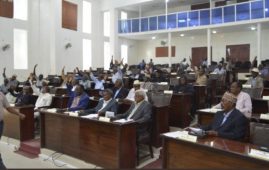IMF’s latest report indicated Ethiopia’s birr is overvalued by over 30 percent. One US dollar was traded to Br 20.67 in August 2015, when IMF staff was organizing its annual report.
In mid-2014, the IMF estimated the birr was overvalued by 10 to 13 percent. Since then, the birr depreciated against the U.S. dollar by 6 percent.
Nonetheless, the IMF report indicated, the value of birr appreciated by about 21 percent in real effective terms in the past twelve months. 
The rise of the value US dollar against the currencies of Ethiopia’s other main trading partners is said to be a major factor in the upsurge of the CPI-based real effective exchange rate of birr.
The report also pointed out, as an indicator of the birr’s overvaluation, importers are waiting for months to get foreign currency while the black market exchange rate has risen in recent months.
IMF reiterated its recommendation that a more flexible exchange rate would be beneficial to the competitiveness of Ethiopia’s exports.
The birr, anchored to US dollar, is determined by a daily interbank auction managed by the National Bank of Ethiopia (NBE). NBE describes the exchange rate regime as a “managed float” with no predetermined path for the exchange rate.
However, IMF said “the de-facto exchange rate arrangement is classified as a crawl-like arrangement” given the stable uniform pace of depreciation of the nominal exchange rate.
IMF also cautioned that external non-concessional public borrowing should slow down citing its recent Debt Sustainability Analysis that indicates an increase in the risk of external debt distress from “low” to “moderate.” The government disagrees with the assessment arguing that EthioTelecom’s debt should be excluded as it is run on commercial basis. Though its audit books are not public.
The report recommended “public investment should be paced carefully, and be subjected to careful cost-benefit analysis”. Moreover, State Owned Enterprises’ (SEO) products – such as electricity – should be priced “to ensure a good return on the government’s investment”.
IMF advised the government to consider public-private partnerships that would enable mobilizing private equity financing while maintaining its ownership control.
Ethiopia’s total savings has surged to about 18-19 percent of GDP, above the sub-Saharan Africa average. However, the report noted that given the government’s investment target of 40 percent of GDP, the rate of saving should further rise to finance planned projects. The experience of China, India, and Korea in the 1980s and 1990s was cited in the report as particularly relevant to Ethiopia in terms phased financial sector reforms that boosts domestic savings.
The list of fiscal sector reforms pointed out in the report include: liberalization of interest rates, liberalization of credit allocation, increased exchange rate flexibility, restructuring and privatization of state-owned banks, gradual opening up to foreign banks, introduction of new financial instruments, and creation of an interbank market, corporate bond market, and equity market.
The second 5-years Growth and Transformation Plan (GTP II), , launched this year anticipates real GDP and export revenue to growth at 11 percent and 29 percent, respectively, per annum on average between 2015/16 – 2019/20. IMF, however, projects 7.7 and 15.2 growth rate for GDP and exports, respectively.
*********





